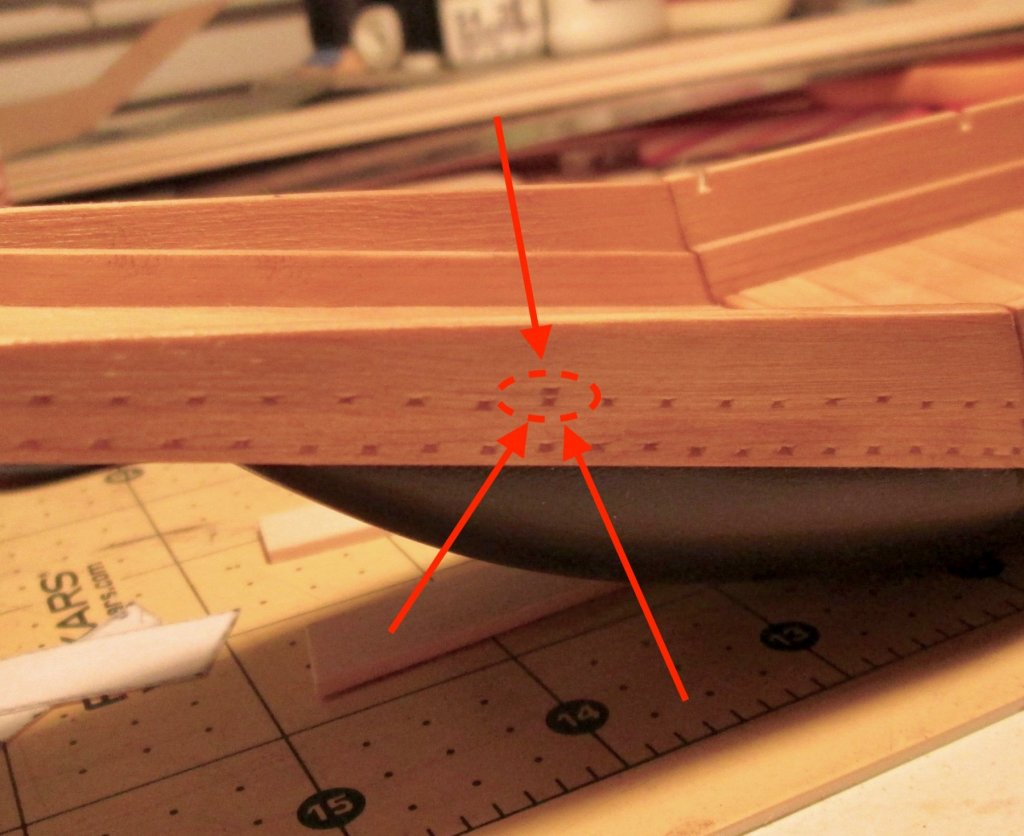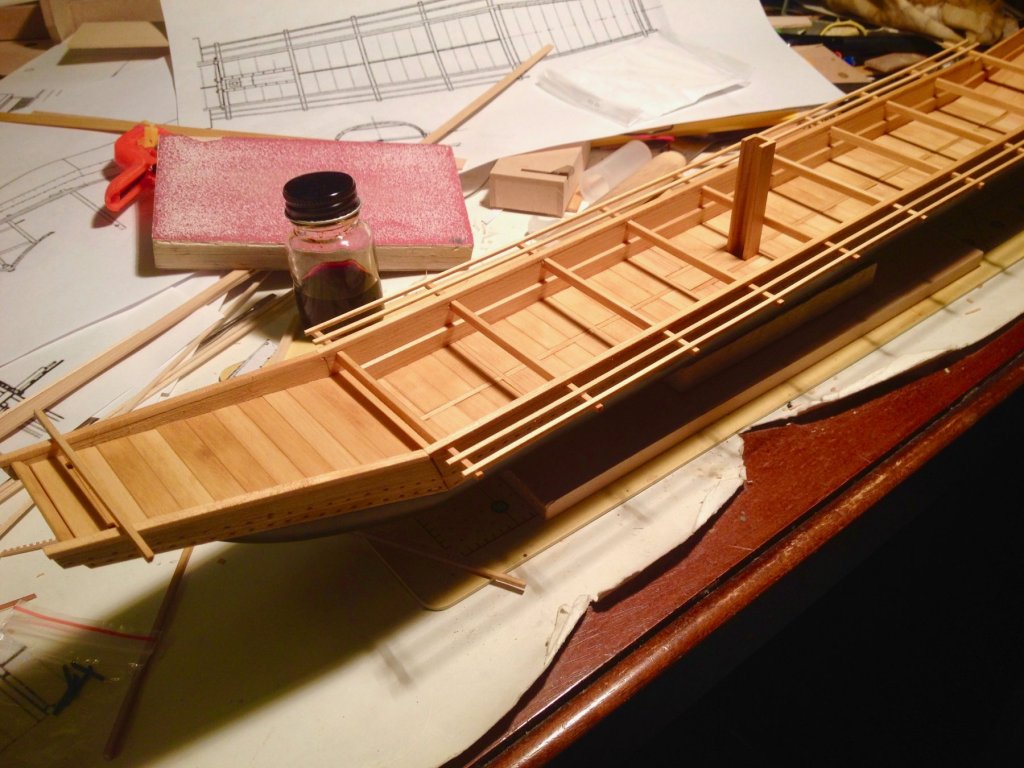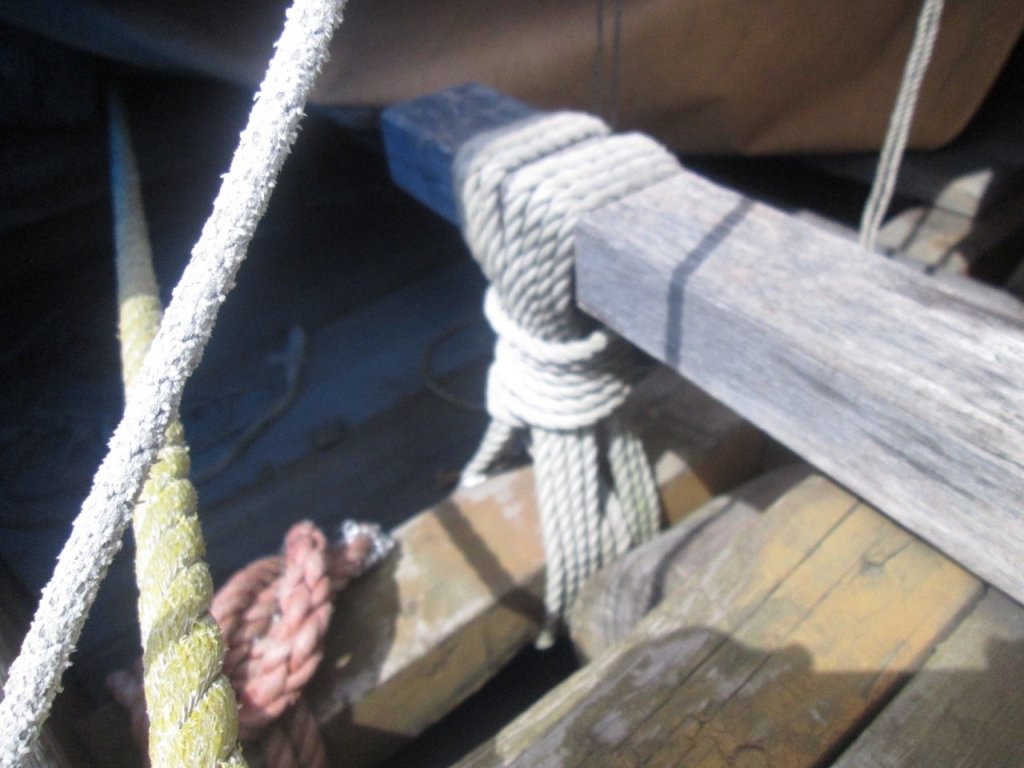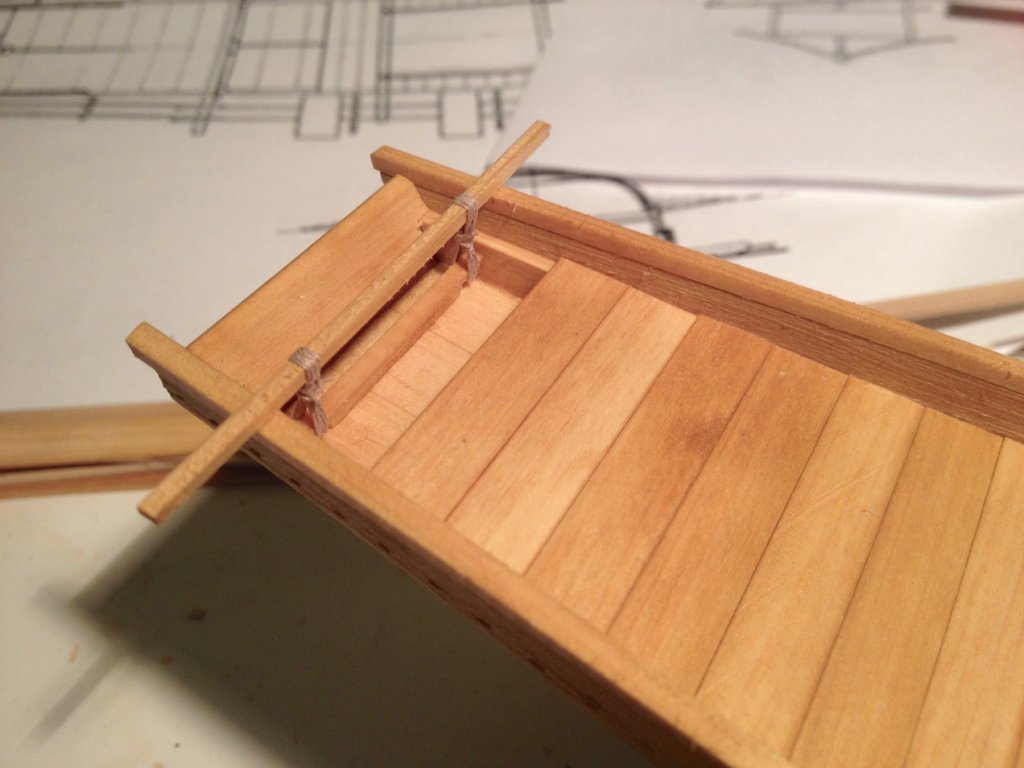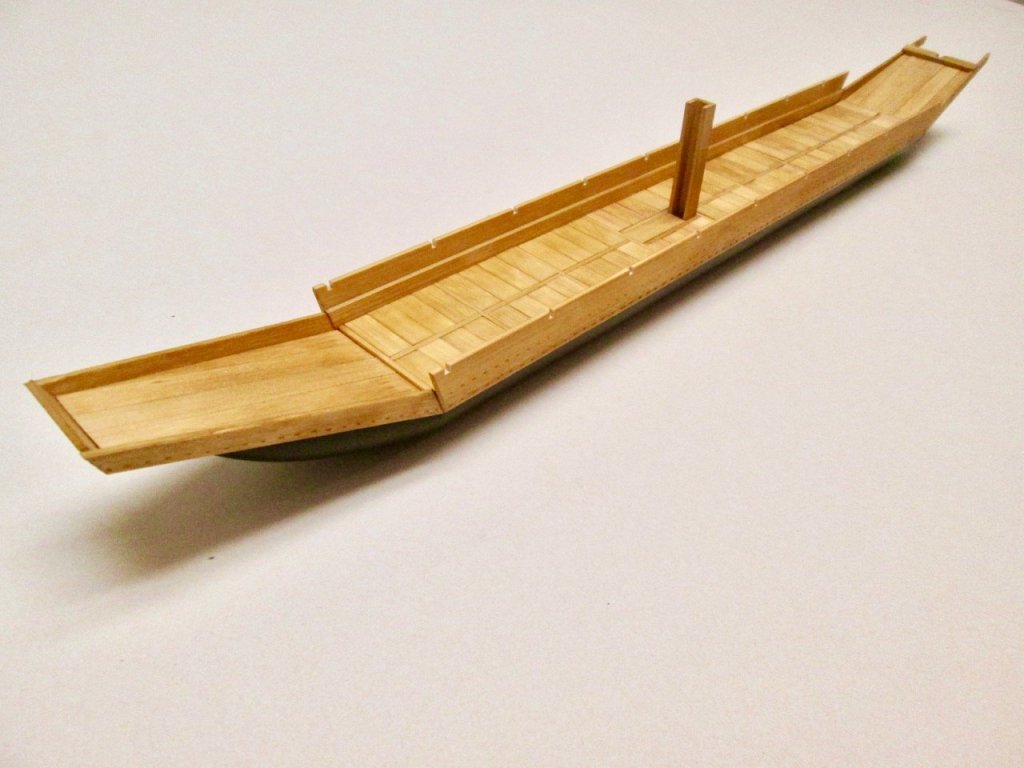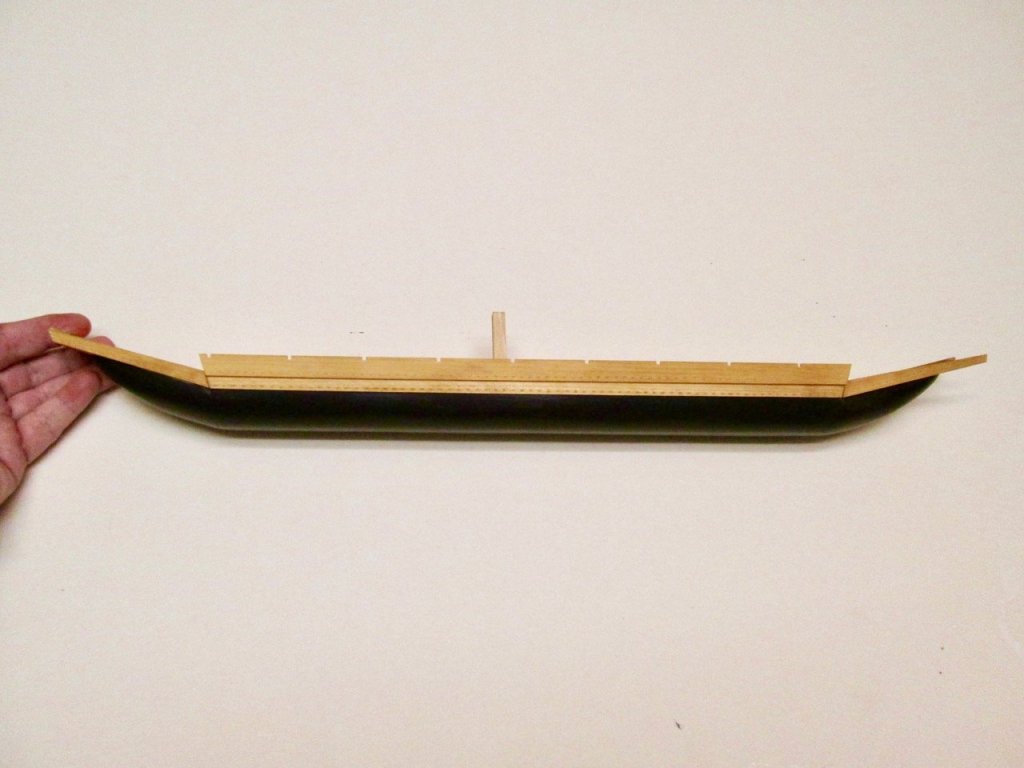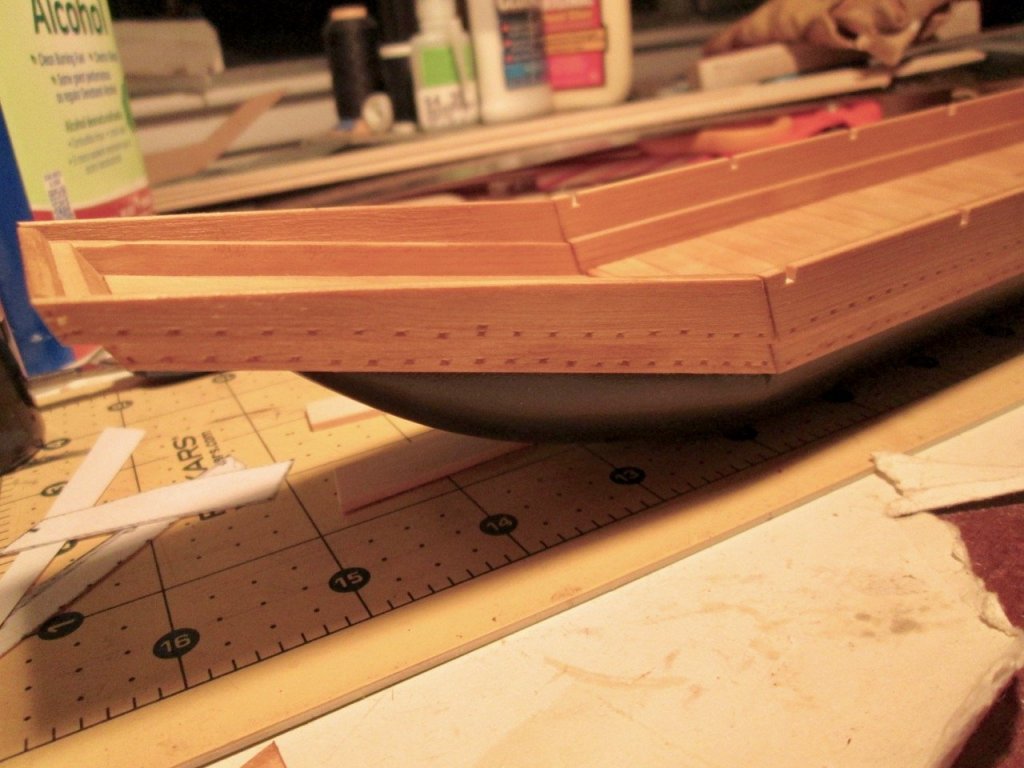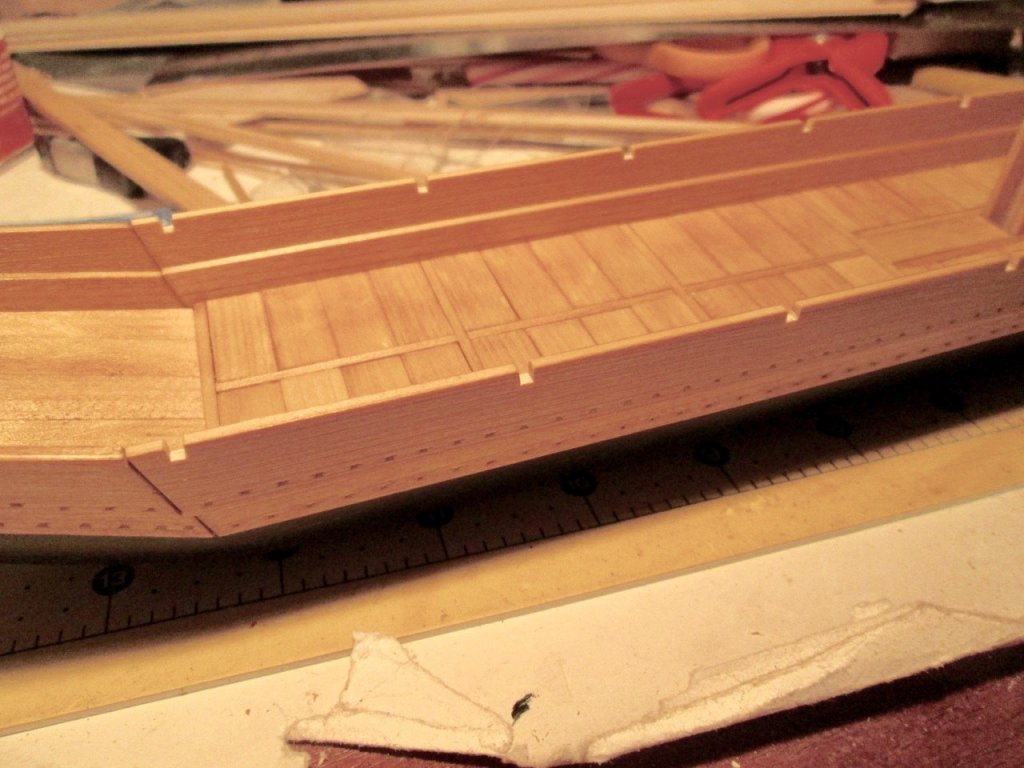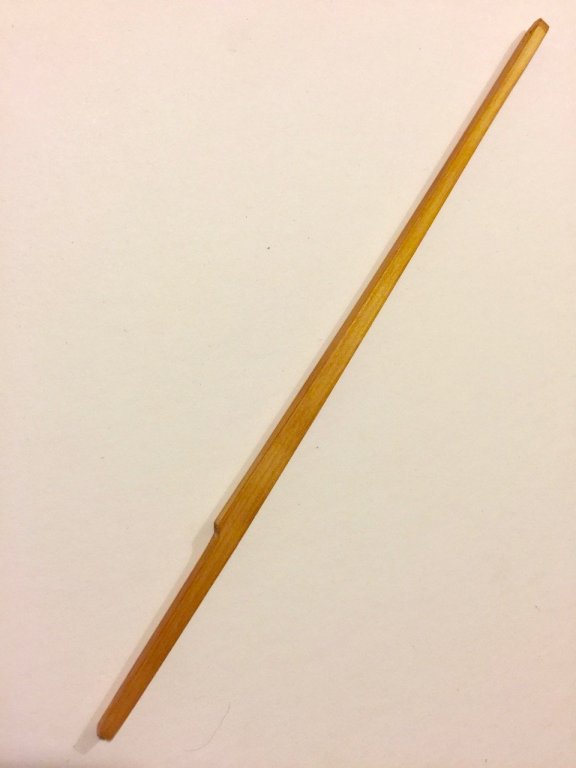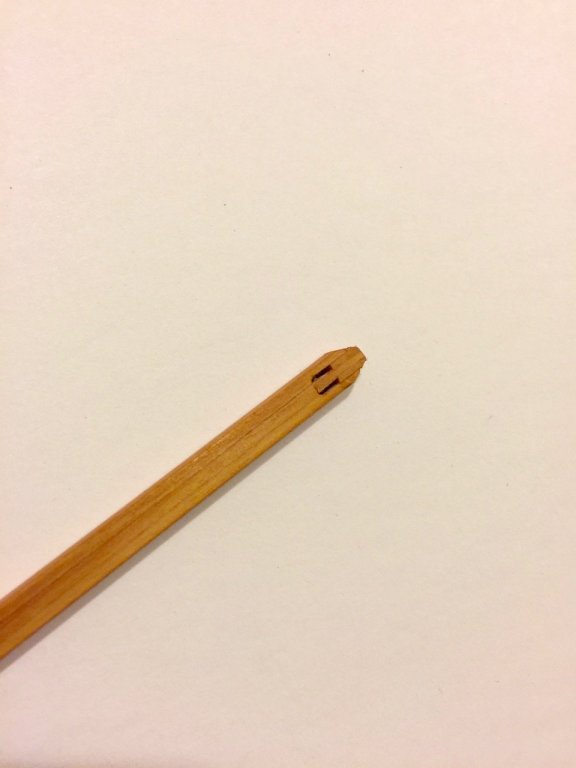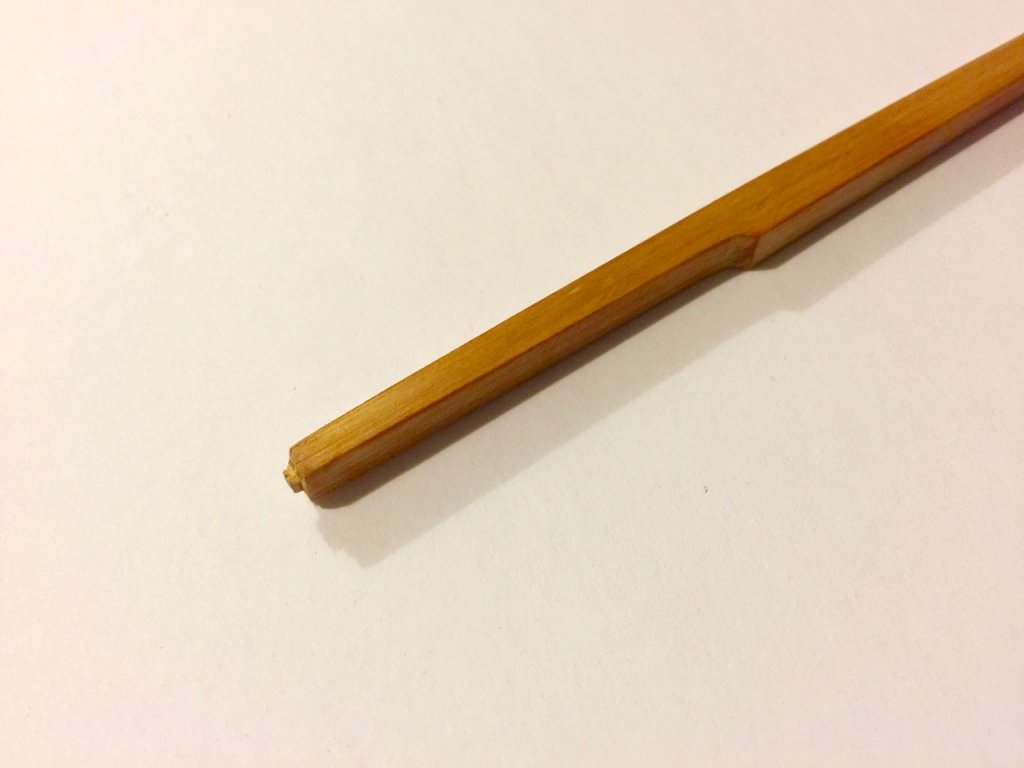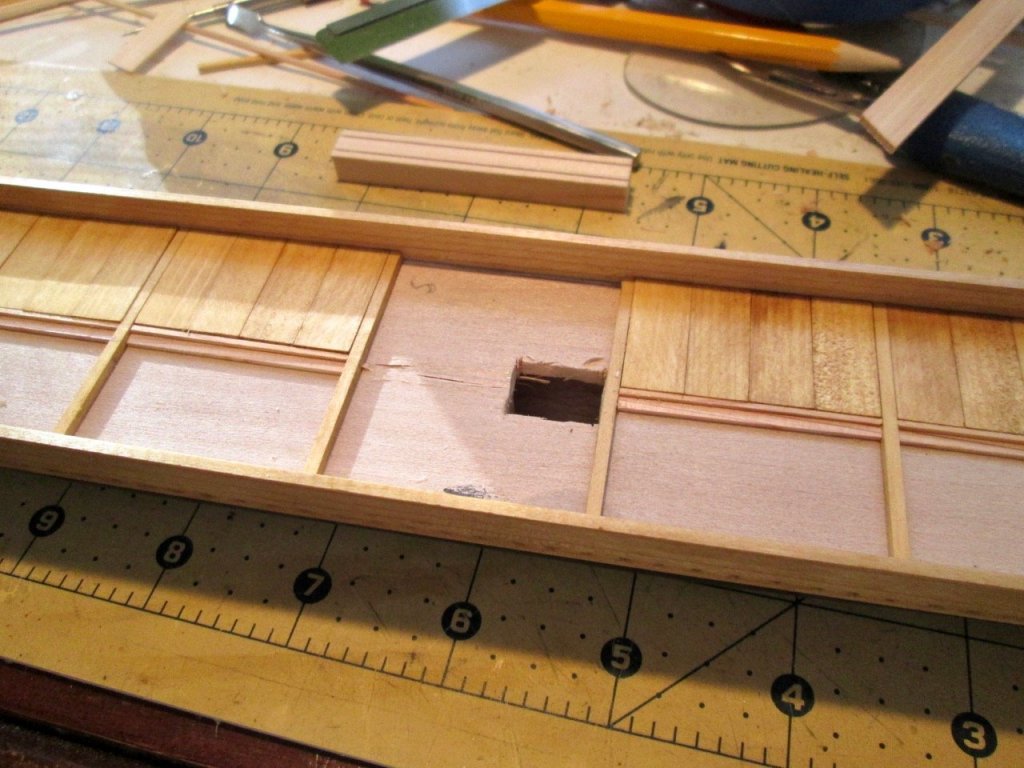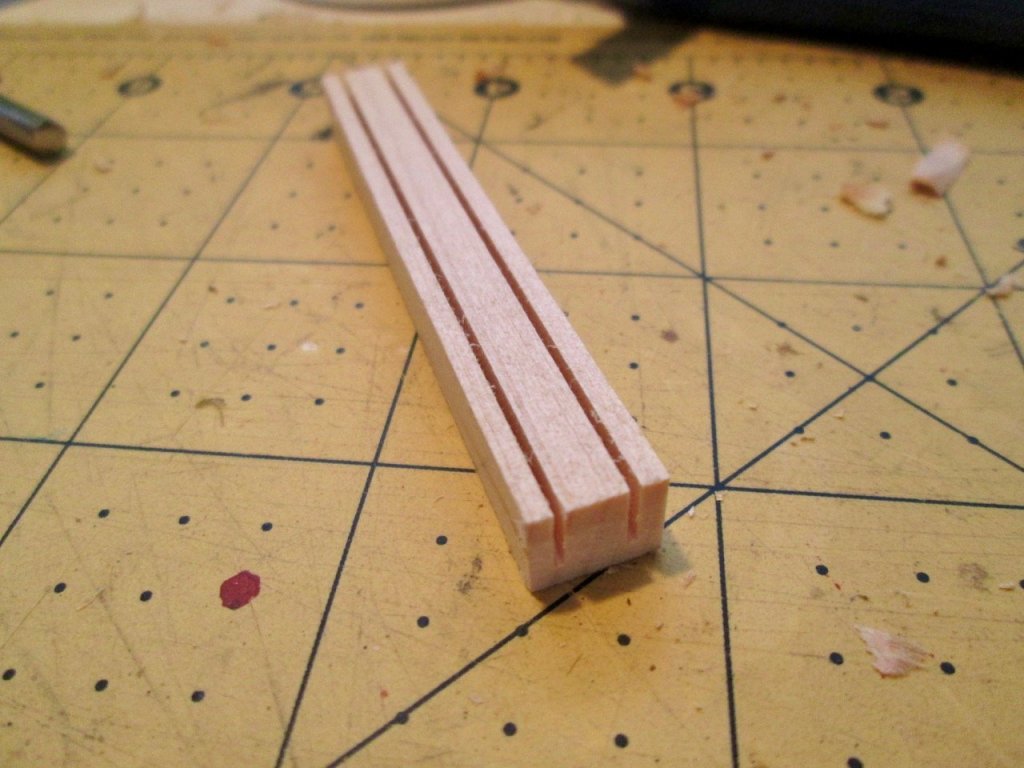-
Posts
1,772 -
Joined
-
Last visited
Content Type
Profiles
Forums
Gallery
Events
Everything posted by catopower
-
Time to get back to posting about the Kamakura period large sea boat... First off, when I initially described the Japanese name Kamakura jidai no dai umibune, I may have been incorrect. I'm thinking now that it should actually be Kamakura jidai no taikaisen. Something to do with the way the Chinese characters are read, which I'm not so up on. For now, without the character for large, 大, (the full name written in Japanese is 鎌倉時代の大海船), it is still correctly read as an umibune or sea boat, so I'll do that. The next step after getting the raised planking into place was to start adding the yataka or the deckhouse. Now, this part of the build gets away from most boat building, as I think this is just a basic Japanese building structure that's been attached to a boat. Having built Woody Joe's Yakatabune kit may have helped a little. The overall structure is similar, though that boat was fashioned after those from the Edo period, which is 300+ years after this umibune. I had a hard time finding any information that helped, though I did buy the book The Genius of Japanese Carpentry, by S. Azby Brown, which did help me out a little bit. Mostly, it served to show me how little I know. Still, there were a couple pictures that showed features something similar to the umibune's deck house. Also, I built Woody Joe's Shinmei-zukuri shrine kit, which I hope would help a little in the old style building construction. But, the umibune's deck house structure is very simple and lightweight. It is basically a frame work with a gabled roof which, on some paintings and models, pitches upward toward the peak. The only fixed walls are the lower half of the sides of the deck house. The ends appear to have been open, covered by no more than some kind of roll down screen, which I suspect must have been fastened down to the floor to keep it from flapping about in the wind. The upper half of the side walls was open, with a cover that is hinged at the top, and it usually depicted as hooked in an open position. From the model that used to be in the Tokyo Museum of Maritime Science. Using the above drawing, I began to lay out it out. Being fairly As you can see in the photo above, I reinforced some of the joints with wire, which has yet to be trimmed off. Also added are the remaining aft outer rails or segai, and the rowing platforms called rodai. Below is a birds-eye view with the mast temporarily stepped. Still haven't decided if I'll have it in sailing configuration or not. And then a close-up of the beginnings of the deck house structure. Just winging it here...
-
Hi jct, What I was thinking I might do is to score the lines of the planking, which should make the piece conform a little better. It would need a light wash of paint to kill the white of the paper that would show through afterwards. I actually use paint washes pretty heavily on my HMS Alert, keeping them really thin. That worked for the most part, though I fully painted the lower hull. When you turn your model over, I expect the issues you were having with the lower hull won't be so prominent. Also, something I learned with the Alert was that as soon as you put paint down on the model, it looks better, overall, if everything has a thin wash of paint on it. Evens out the look.
-
Hi jct, I understand the problem you faced there. I have been thinking about a similar issue I'll face when I get to the hull planking of my 1/96-scale HMS Mercury, which also has planking added in strips 3 or 4 planks wide. I didn't have that problem with the HMS Alert, because it has the clinker planks that go on afterwards and cover that part up. I'll probably be painting too!
-
Heinrich, I'm happy to see your build of this Shipyard paper model. I built the 1/96-scale HMS Alert kit, which has very similar construction, including the clinker planking. I've often thought about building Shipyard Le Coureur kit. After all, they did engage in battle. I will enjoy following your build here.
- 21 replies
-
- shipyard
- le coureur
-
(and 1 more)
Tagged with:
-
Hi Dan, Good question. On one boat in particular, I have had that same question. But, on these boats, I'm sure the planking is too thick to run the fasteners all the way through. I believe they're about as deep as that large fastener sitting on top of the wood in that last posted photo. So, the fasteners would have to be added to both faces of the planking. I don't know if they are done inline or staggered or if they even worried about it. I'll ask Douglas about it. Been meaning to do that because of the Aganogawa-bune, or Agano river boat, which is a beautiful, slender boat that his students at Middlebury College built a replica of. Here's a photo from his blog, where he basically answers this question. A mortise is cut for the fastener, in this case, to the thickness of this fastener. Douglas Brooks has a great blog site, which I think people here would really enjoy. Here's the entry for the fastener, which he refers to by the name used by his teacher in Okinawa, a huundu: http://blog.douglasbrooksboatbuilding.com/2009/12/huun-du.html Oh, I just read in the blog that his teacher in Okinawa like to lay these out with an even stagger between the inside and outside. A very useful blog!
-
Okay, one last post about the Dobune. I found a few photos of a half-scale replica being built. The photos were on a Facebook page for boatbuilder Nasu-san. I don't recall his first name. He instructed Douglas Brooks on the building of a Ukai-bune, or cormorant fishing boat, earlier this year. Some of you who attended Douglas' talk in Mystic a couple years ago may also recall seeing a short video of Nasu-san pounding nails with a lively rhythm. I don't believe Nasu-san is building this replica, the photos were just on his page. There are more photos on Nasu Boatbuilding's Facebook page, if you're interested. It's in Japanese, though, but you'll find them in the Photos section: 那須造船 Note how the thick lower hull plank is actually more of a carved log. This type of construction seems pretty rare, and I believe it's considered a transition between the semi-structure hull type, as shown in my umibune model, and a structured, or fully planked hull.
-
Beautiful job on your build, Art! I really like this kit – I have one up in my closet I've been saving for a rainy day. It's too bad these kits are out of production. Great blogging too!
- 36 replies
-
- sakonnet daysailer
- Midwest Products
-
(and 2 more)
Tagged with:
-
Hi Dan, It's great to see you here – by all means pull up a chair. Thanks for the nice comments. Funny thing is that it often FEELS like I'm trying to figure out a puzzle box... Ken, I was originally looking at taken on a different boat to model, a net-fishing riverboat used on the Agano river in the Niigata prefecture. It uses a lot of those fasteners and I couldn't manage them in the small scale and type of wood I wanted to use, they were too soft. So, I turned my attention to the Kamakura period sea boat at 1/50 scale. Most wasen models in Japan are either sugi (cedar) or hinoki (cypress). But, looking at the Dobune in that photo, you can tell from the wide, wavy grain pattern that it's a different wood. I suspect it's a much harder wood, which I think you'd need in order to cleanly use fasteners like that. I do want to experiment with modeling this feature at some point.
-
Hi jct, Sorry I'm late to the party! I'm really glad to see another Shipyard build. I saw this in the shop a couple months ago and had to slap my own hand to keep from buying it. It's a very nice looking kit and it looks like you're doing a great job! Thanks for the nice comments earlier. I don't think I deserve them, but I really did have a LOT of fun building one of these paper kits. Thanks for the tip about the punch. I've heard of others using and recommending them, but I still haven't tried one out yet. But, I know that you'll get much cleaner rounds with one. I'll be following along, but everything is looking great!
-
Ken, if you like those fasteners, you'll love this boat. It's a kind of semi-dugout called a Dobune (doh-boo-nay). The were used up until the 1960s, I believe, off the Noto peninsula in the Sea of Japan. This is only a model of one, but take a look at the bow. The photo is courtesy of Douglas Brooks, who took it when he was in Japan working on a boatbuilding project in Himi last year. And Carl, since you mentioned his book, let me take the opportunity to plug it here! This is a "must have" book if you're interesting in Japanese traditional boats. I can't recommend this book enough. It's not a cheap book, but it is loaded with information and it is written in a style that makes for easy and fascinating reading. If you're interested, I recommend buying it direct from the author off of his website as it helps to support his research work: http://douglasbrooksboatbuilding.com/japanese_wooden_boatbuilding.html
-
Ken, those are actually rectangular mortises that were cut, plugged and painted. The painting is just decorative. The mortises are cut, and small rectangular pilot holes are cut through them into the stem to take large, flat, iron nails. These are nails that I got from Douglas Brooks, who has a small supply of them for his own Japanese boatbuilding projects. The one on the right is an original, hand forged in Japan. The two on the left were made for him by an American blacksmith from galvanized steele. So, those designs you like are just painted plugs, the boat does have some nice carved design work. From what I've seen, carvings like this aren't all that common. Nor is the white paint of the mortise plugs. It just depends on the region. But, you might appreciate the bow of this boat built in Okinawa, which uses wooden fasteners. This image is of a boat called a Sabani. You can see more about it on Douglas Brooks's website.
-
Thanks Carl! But, I'm surprised at the length of page 1. I'm curious how the system decides when to paginate. It may just be a mystery of life... Nothing to post about the model today. But, I do need to share that my brain turned to mush last night. I had the day off and was doing online research on some Facebook posts I saw recently regarding some boat types from the very southwestern corner of Japan's southern island of Kyūshū. The boats I ran across in posts looked similar, but all descriptions were in Japanese and I can only read a very small amount of Japanese. So, I end up doing a lot of online translation. It takes a long time to translate and make sense of documents, figure out what their sources are, and then relate different documents together when they use different terms for similar types of boats. In the end, I determined that I was looking at two distinctive types of boats, though they were closely related by rig and some of their hull features. For one of the types, there turned out to be a treasure trove of information on its design, sailing characteristics, construction and so on. Apparently, the information was collected by a man who's father built them. He collected the information so it wouldn't be lost forever. At the same time, I found some old information on a former boat builder who became too old to continue the work. He turned to building models of his boats and there was information on an old exhibit that took place in a resort in the area where these boats were from. I think at least one of his models may still be on display there. The type is called a Satsuma-han-sen or Satsuma-gata wasen, which simply means Satsuma-type Japanese traditional boat. Being built in the far south western corner of Japan, there is a lot of Okinawan influence (= Chinese influence) on the design of the rig. The information I found suggest heavy western influence and relates the rig to the lug rig. But, I think it's actually more related to the junk rig. In any case, I was emailing back and forth with a couple people in Japan, checking with boatbuilder Douglas Brooks, translating text all day, looking up terms, referencing and updating my notes. Even with breaks, I barely got away from my computer and I think I shorted out my brain... But, on the positive side, I discovered that I had actually seen a replica of this type when I visited the Toba Sea-Folk Museum in Japan last year, and I have almost 2 dozen photos I took of the boat's details. But, after all that, I'm not actually planning on modeling the boat, but just understanding the type and to keeping up-to-date with the wasen enthusiasts in Japan. As soon as my brain solidifies, I'll get back to posting about the Kamakura period sea boat...
-
Here's a nice short post for a change... I'm constructing the rudder, or kaji, on the model in a similar fashion to what I've seen of the museum models. You'll notice that those models aren't very detailed in this area. Once I did was to use a separate rudder post, with the rudder itself glued onto that. The actual rudder and rudder post may have actually been a single piece. Given the size of tree needed to make up the hull, it's certainly not out of the question, as long as a single piece was sturdy enough. There is a small hole at the top end of the rudder through which a rope was tied. This rope supports the weight of the rudder, making steering easier. The depth and large size of the rudder itself allows it to make up somewhat for the lack of a keel. Even so, I doubt that this type of boat could sail into the wind to any degree, relying instead on oarsmen for that. As with later traditional Japanese boats, there were no rudder hinges. Instead the rudder post fit through a hole in the ōtoko, the great beam at the stern. The post is only slightly smaller than the opening in the ōtoko, and the opening is notched so that the rudder itself could pass through the notch, but the notch is too small for the rudder post to slip out. I've been reading recently that these were greased to allow easy movement of the rudder. But, friction meant that the hole would wear out over time and become enlarged and the ōtoko would need to be replaced. On the Hacchoro photo I showed in my last post, the rope tie-down was actually to secure the ōtoko. This could be untied and the ōtoko could be removed and easily replaced. This boat doesn't seem to have a similar tie-down feature, and I haven't been able to determine yet how the ōtoko was secured or removed.
-
Hey Slog, Your railing looks absolutely beautiful to me. I can't imagine that mine will look nearly as good when I get to it on my V108. Really lovely work! Clare
- 244 replies
-
- borodino
- dom bumagi
-
(and 1 more)
Tagged with:
-
Thanks for the nice comments Carl, Druxey. Druxey, I'm giving your suggestion a try. When I looked at it last night with my eyes and not through a camera lens, I have to admit (Carl) that it's not very noticeable. Still, I added water, but this wood soaks it up like a sponge and didn't change much. I was reluctant to add any more water as I could see the area that was getting wet was growing too much. Doesn't look like the dye has been affected any. Looking at it today, it hasn't changed much. Seems that the Japanese wood is actually too hard to swell much. It is a very brittle wood unless wet. Both holes are a little smaller, and if I go over the correct hole with the "Tooig" it will probably look better. Unfortunately, the Tooig is easily misplaced, so the repair will have to wait a bit! Pressing on, the next step was to add the planking for the main deck house, or yakata. If you've looked at my other builds, you might have noticed that this is the same word as in Yakata-bune, a pleasure boat of a much later period, with a similar type of deck house. The large Umibune of the Kamakura period has a second small deckhouse at the stern for the pilot. This house is referred to as the tomo-yakata. And for those of you who are enjoying the Japanese terms, don't think for a moment that I have all these things memorized. I'm a student of wasen, or traditional Japanese boats, and I'm having to look this stuff up all the time. I laid down the raised deck for the yakata, and you'll notice that these had to fit precisely between the existing beams, or futabari. These are narrower planks than the ones on the main deck and they run the full width of the boat. To support them, I simply installed ledges along the hull planking, in between the beams, for the planks to rest on. One problem I ran across was what to do about the space under the upper deck. It seemed a little odd to just leave it open, but I had no information on whether these would be closed off or not. This is pretty much an open deck boat. The yakata, houses the passengers, but crew and some cargo would just be sitting out on the deck. If these openings were closed off, it would just be that much harder to store goods under there. The main deck planking might even be left off under this space, so as to allow for more cargo. Unfortunately, there just isn't much information available. I've seen museum models that appear to be done both ways. Above is a photo I posted earlier, but here I am focussing on the aft edge of that upper deck. This is about as good as it gets with most of the information I have. There's another photo of a similar model that looks about the same. There is clearly nothing visibly closing off this space, unless it is well recessed, and I don't see a reason it would be recessed. But then, we come to a larger model that I believe was more recently built. The above model was 1/20-scale. The model below is most likely 1/10-scale. The photo was taken early this year by my friend and fellow ship modeler, Mr. Masami Sekiguchi, who has been a tremendous help to me in my studies. This model, if I'm not mistaken, was in a gallery at Kanagawa University, which has a Japanese Cultural History department. I'd hoped to visit the gallery last year, but didn't have time. It's hard to see in this photo, but the underside of the upper deck, and also the raised deck at the bow, appear to be closed off. Of course, it's also possible that at this scale, the builder decided to do that, in part, so as not to have to speculate on the structure underneath these decks. It's actually one reason I didn't try to build my model at a larger scale: The bigger the scale, the more detail that needs to be included – details that I don't have information on. In any case, here's the completed upper deck. Also note that I've added a beam at the stern. This beam supports the outer rails, the segai, reinforces the hull planking, and serves as a place to secure the rope that will help support the weight of the rudder, or kaji. Later, a lower beam will also be added when I complete the structure at the stern. You'll note that I placed a kind of splash board on the forward edge of the ōtoko, or great beam. This was speculative, and I've actually removed it after looking at the various museum models.
-
Thank you Mark, Carl. Carl, here you go: Okay, but it may be more a case of being "Shipmodeler-ese!" I didn't have any photos of it, but I used a piece of painters tape to create the line for the mortises, then I just used my mortising tool to make the impressions along the edge of the tape. The biggest problem I encounter is when I hit a hard spot in the wood that pushes aside the "tooth" of the tool. Anyway, the next step was to add the beams, or futabari, and the caprail. Japanese terms vary between regions and probably over time. On other wasen, or Japanese traditional boats, the caprail is called the uwakoberi. By the way, I learned recently that of the log hull, the bow section is called the omotegawara, the main hull section is called the dōgawara and the stern section is called the tomogawara. Kawara is a common term for the bottom of a boat. In the above photo, you can see the bottle of wood dye I've been using. If I didn't dye the wood, the model would have a similar color to that of untreated basswood. In any case, with the beams in place, I then added the outboard rails, which are called segai. On the real ship, these were tied down to the beams, so that's a detail yet to come. One thing that bothered me about some of the museum models I've seen is that the stay for the mast is attached to that beam at the bow. The problem is that I don't see any way that the beam could be securely fastened to the hull. So, I decided to employ a method used in other later boats, which was to tie the beam down to another beam which is mortised into the hull planking. Below is a photo I took of one of the replica Hacchoro boats at the port of Yaizu last Fall. You can see how a beam is tied down. It can be untied and removed when not in use, etc. I took the same idea and applied it to this bow beam on the umibune. The photo above shows the beam tied down into place. I temporarily removed the deck planks here. I also notched them to allow for the passing through of the rope. This would, of course, necessitate the ability to remove the deck planks as needed, but removable deck planks is a common feature of traditional Japanese boats. The only thing is that if that's the case, some of the planks should probably have a finger hole to allow one to more easily pull up the planks. Also, certainly on Edo period boats (400 or more years later), a pattern was commonly cut into the surface of planks like this to make it visually easier to identify which plank goes where. I haven't seen the feature or the finger holes on any of the museum models, so I'm not incorporating them here – the builders probably know something about these that I don't!
-

New Member from Sunny Southern California.
catopower replied to ruben_dominguez's topic in New member Introductions
Hi Ruben, Have you looked into the Ship Modelers' Association that meets in Fullerton? I don't think they're terribly far from you and there's a lot of great talent there. I recommend making one of their meetings. I maintain a membership with the group, but I live in Northern California, so I've never made one of their meetings. Together with this site, I think you'll get lots of good help and inspiration on on your ship model project. You can find their website at http://shipmodelersassociation.org. Clare -
Next step was actually very simple, which was to add the upper planks to the hull. These were notched where necessary for the support beams, called futabari. I created the simulated mortises on the planks and then glued the central plank into place, slightly overlapping the lower plank. On the real ship, I suspect this was actually made up of separate lengths, fastened together end-to-end in some way. As you can see, I had a little trouble with the alignment of the mortises in the upper bow plank. I may try to fix this later.
-
Don't know why I kept calling you Mark, maybe because you posted a note to Mark at the end of one of your posts and I wasn't paying attention and thought it was your signature(?). Anyway, yeah, I heard back on my query to Emilio Marletti. I believe he's the president of the company. Apparently the PE sheets for the ME version of the kit were laid out completely differently. It's not that the parts were different, but he has to figure out which parts you mean exactly, so he knows which sheet or sheets you need. Things get re-engineered for efficient production, so it's quite possible hooks are on a sheet that's also used for other kits now. I was trying to figure a way to show him the right parts, but it sounds like you already took care of it. I'm sure he'll figure it out from there.
-
Before going any further on the deck planking, it was necessary to cut an opening in my false deck for the mast. I haven’t decided if the mast will be mounted in a raised position with a sail flying or if it will be shown lowered as shown in the plan drawing. The mast itself is similar to one from Woody Joe’s Higaki-kaisen kit. I have no way of knowing how accurate this is, but it is based on the drawings and on museum models. Basically, it’s a square cross-section mast that is thick at the base and tapers slightly towards the top. At the very top, it's cut for a pair of sheaves. Again, I have no access to information on the historical use of sheaves or blocks by the Japanese. One gentleman in Japan who was connected with a group that operates a modern replica boat had commented to me that the blocks on the replica (17th century boat) were modern and that the Japanese didn’t use blocks back then. Of course, I could have mis-understood him. Still, it was enough to make me think about the need for some historical information on simple technologies like these. As you can see, I started the deck planking at the same time. Below is the piece for the mast. I cut two slot using the table saw and chiseled out the center. I cut a mast support and the finished shaping the mast to fit it. At the bottom end of the support, I glued a wooden base, notched for a tennon in the end of the mast that would help lock it into place when erected. The support assembly was glued to the bottom of the hull, and planking of the deck was then completed. On a replica of a 17th century fishing boat, the single plank directly in front of the mast was notched to completely cover the opening in the deck. This would be replaced with a second plank, cut to leave an opening for the mast, when stepped.
About us
Modelshipworld - Advancing Ship Modeling through Research
SSL Secured
Your security is important for us so this Website is SSL-Secured
NRG Mailing Address
Nautical Research Guild
237 South Lincoln Street
Westmont IL, 60559-1917
Model Ship World ® and the MSW logo are Registered Trademarks, and belong to the Nautical Research Guild (United States Patent and Trademark Office: No. 6,929,264 & No. 6,929,274, registered Dec. 20, 2022)
Helpful Links
About the NRG
If you enjoy building ship models that are historically accurate as well as beautiful, then The Nautical Research Guild (NRG) is just right for you.
The Guild is a non-profit educational organization whose mission is to “Advance Ship Modeling Through Research”. We provide support to our members in their efforts to raise the quality of their model ships.
The Nautical Research Guild has published our world-renowned quarterly magazine, The Nautical Research Journal, since 1955. The pages of the Journal are full of articles by accomplished ship modelers who show you how they create those exquisite details on their models, and by maritime historians who show you the correct details to build. The Journal is available in both print and digital editions. Go to the NRG web site (www.thenrg.org) to download a complimentary digital copy of the Journal. The NRG also publishes plan sets, books and compilations of back issues of the Journal and the former Ships in Scale and Model Ship Builder magazines.

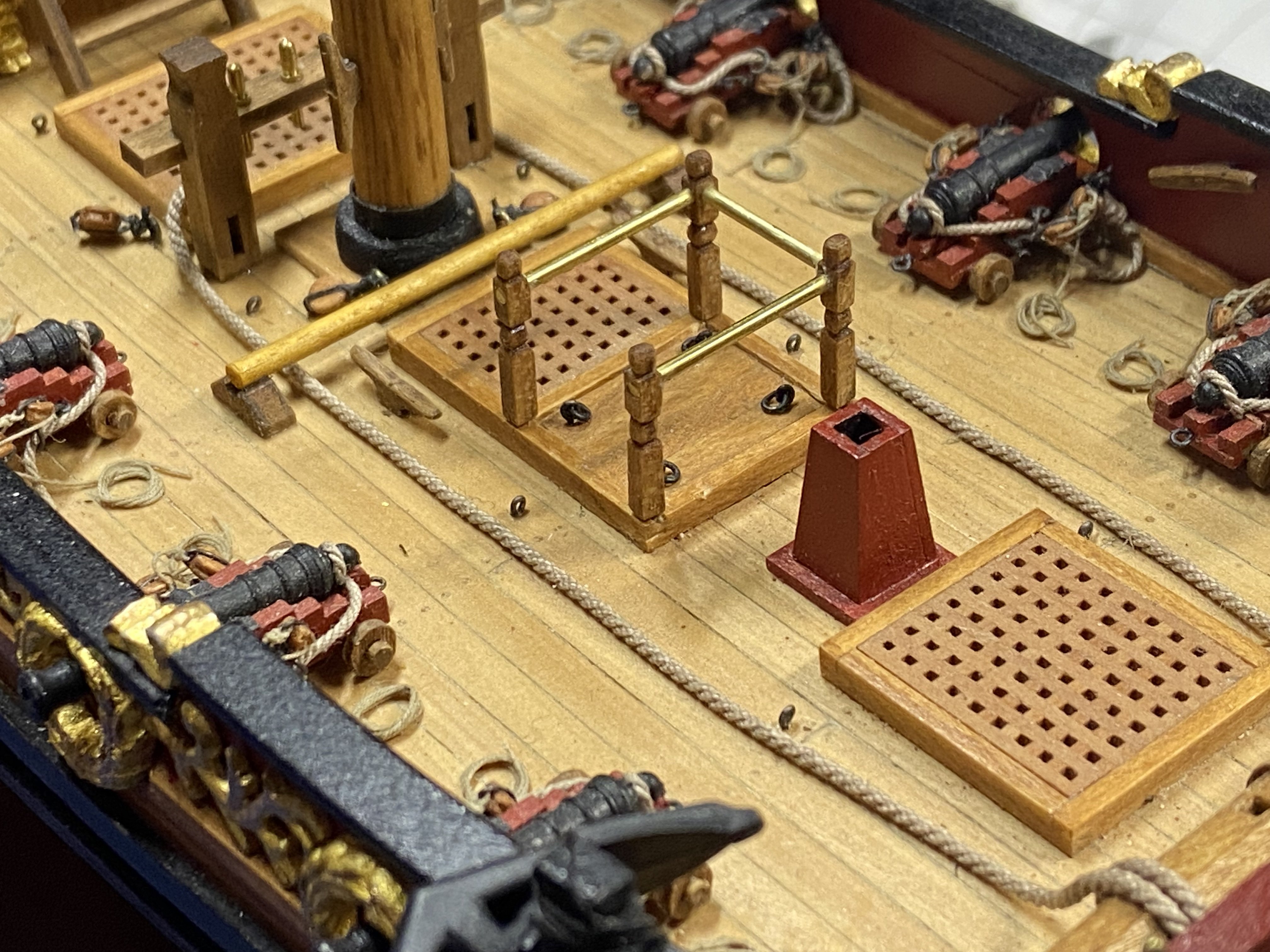
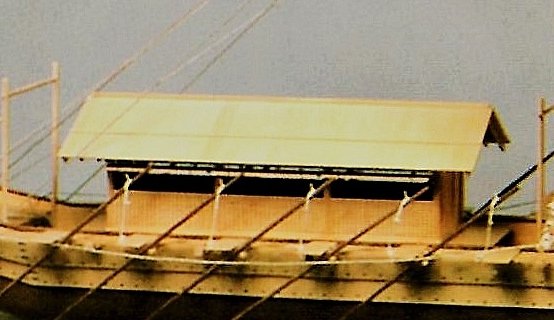
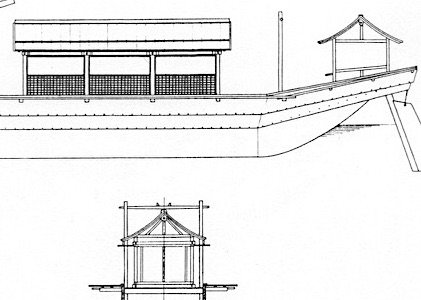
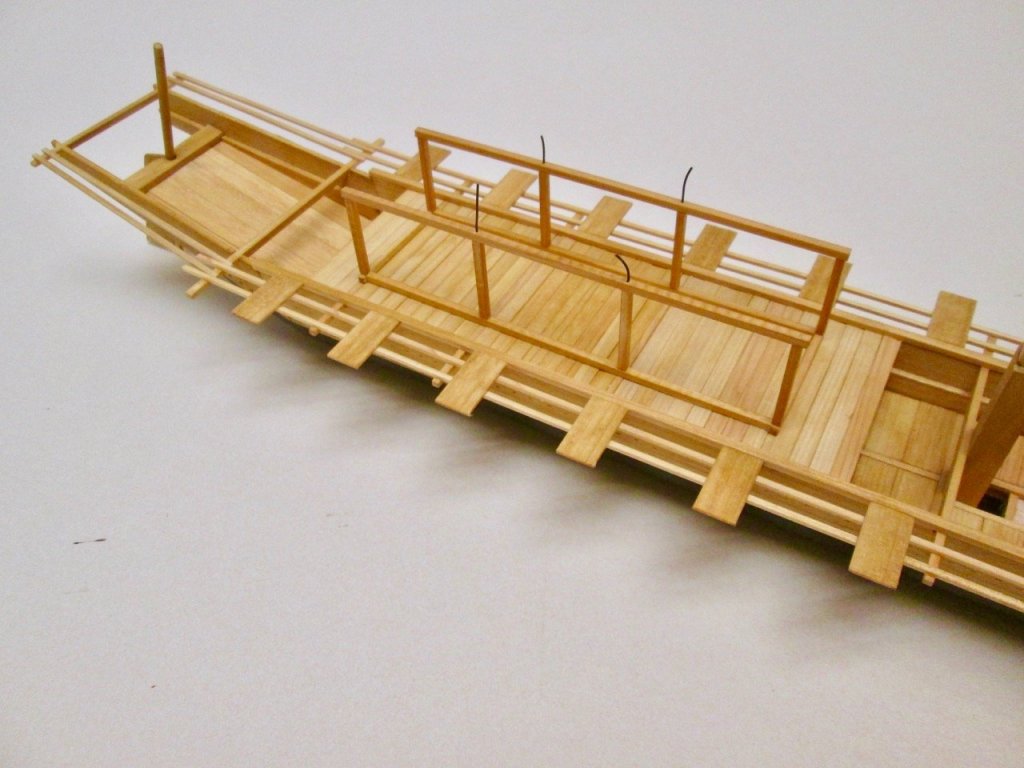
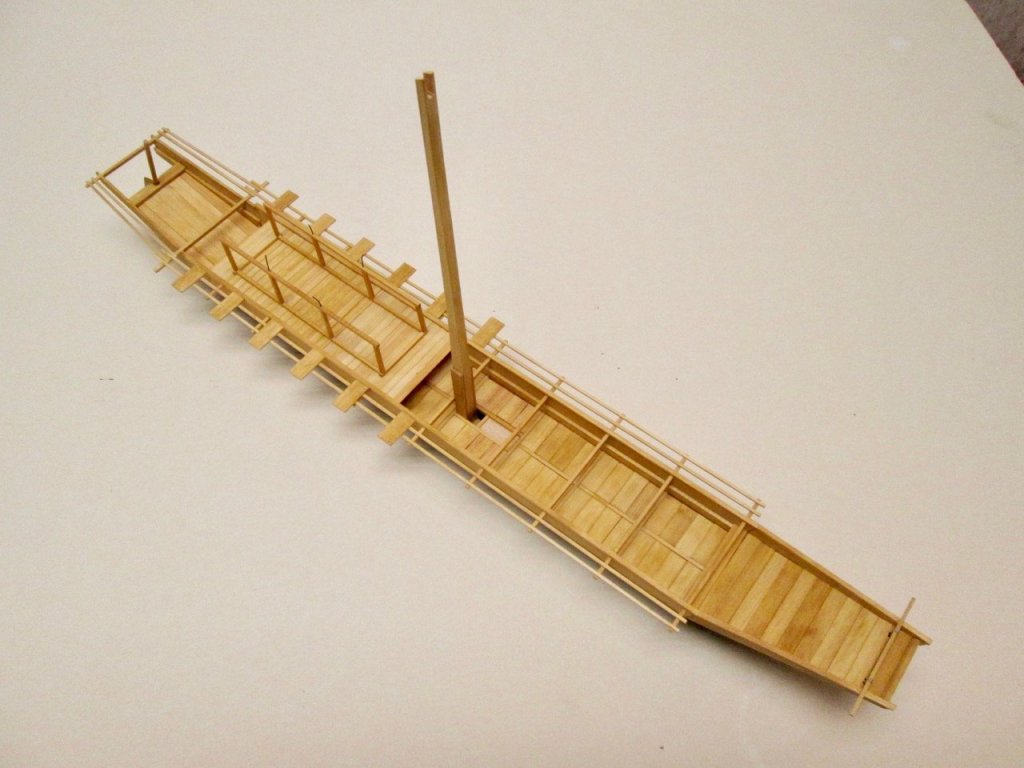
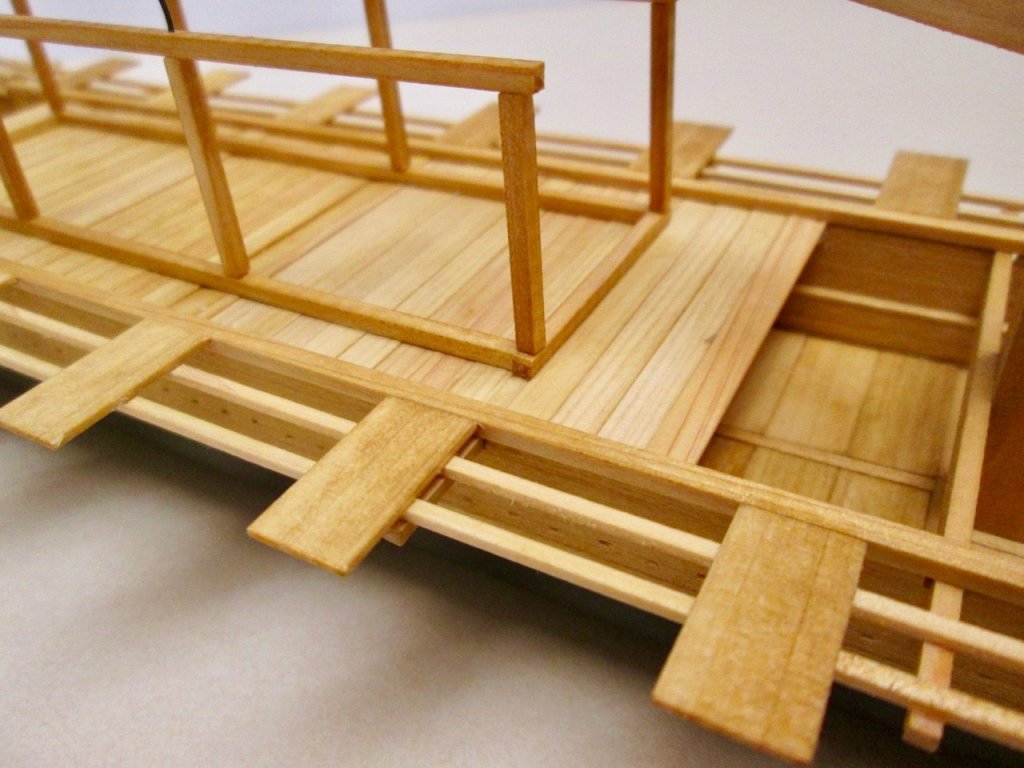

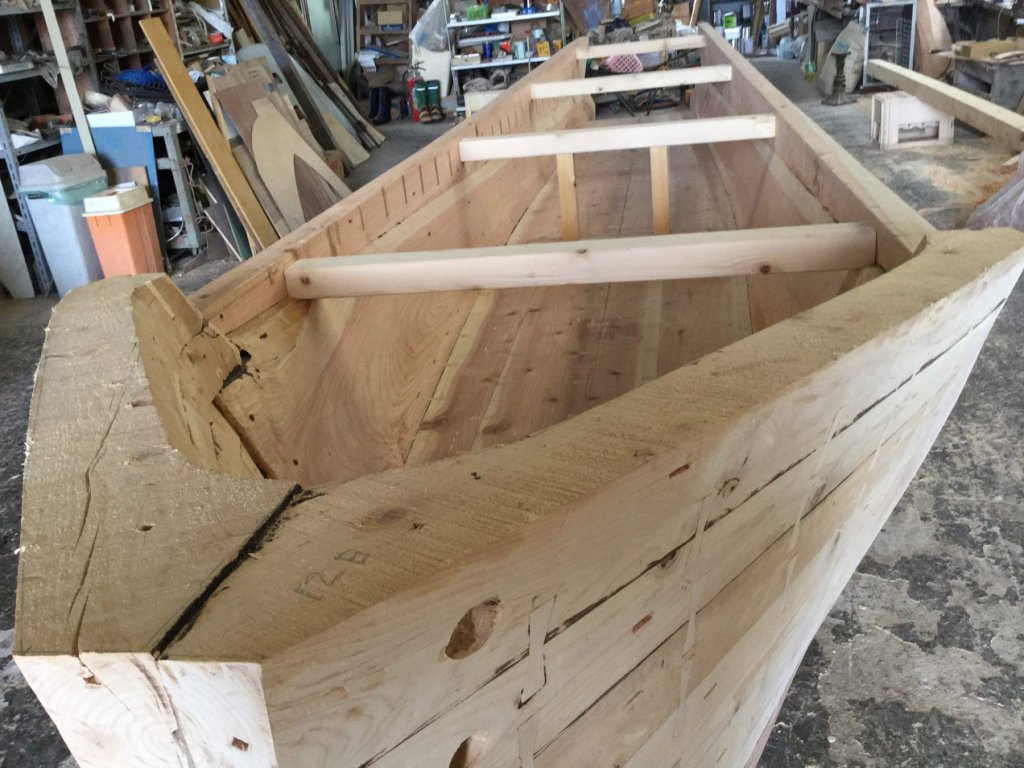
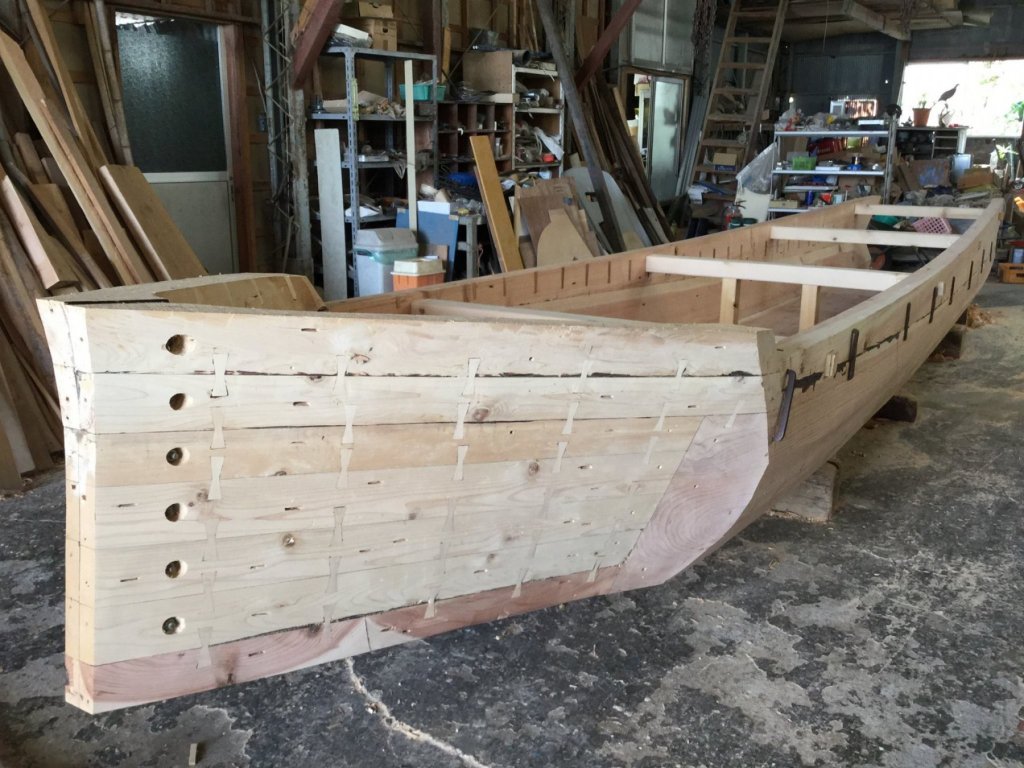
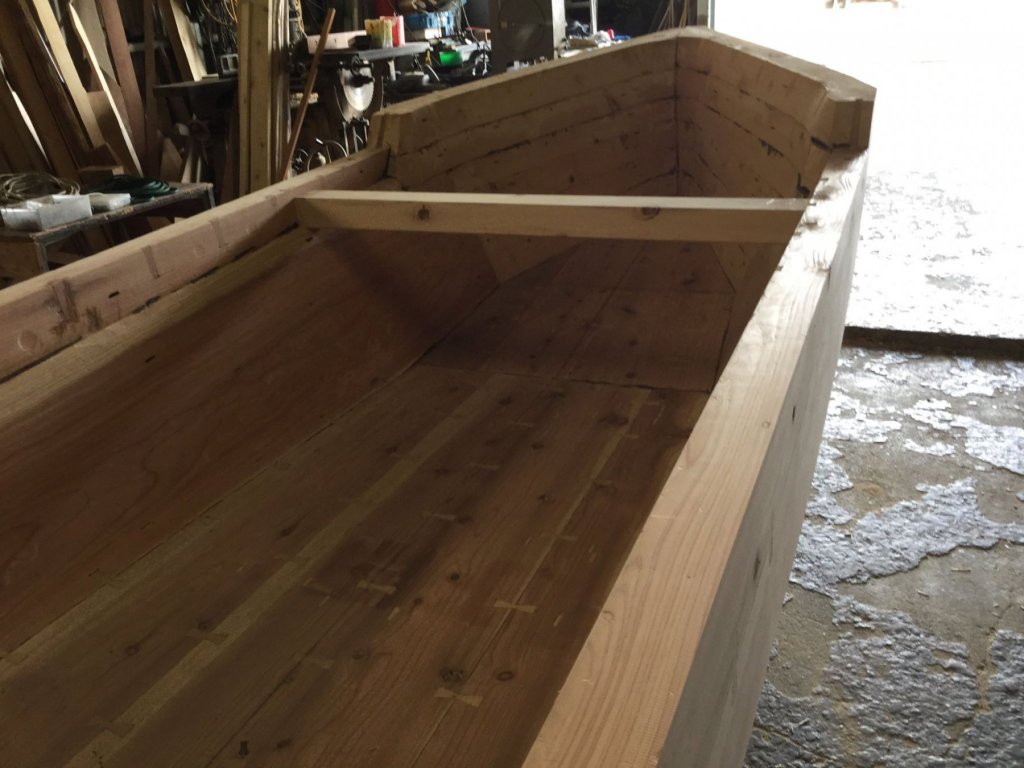
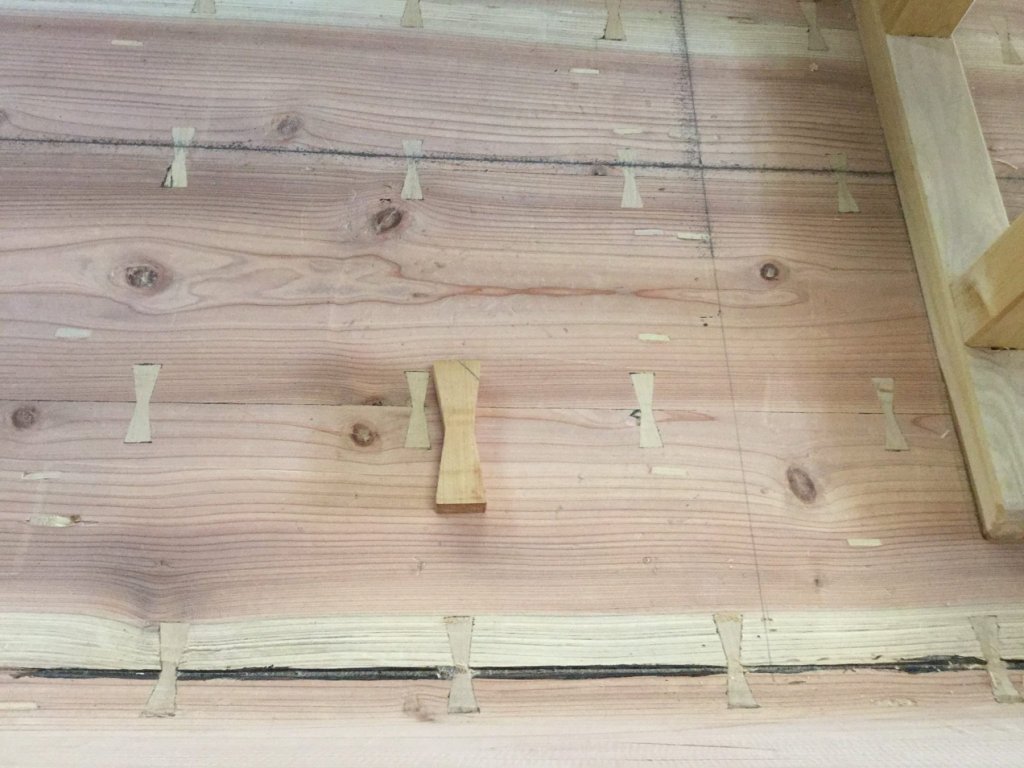
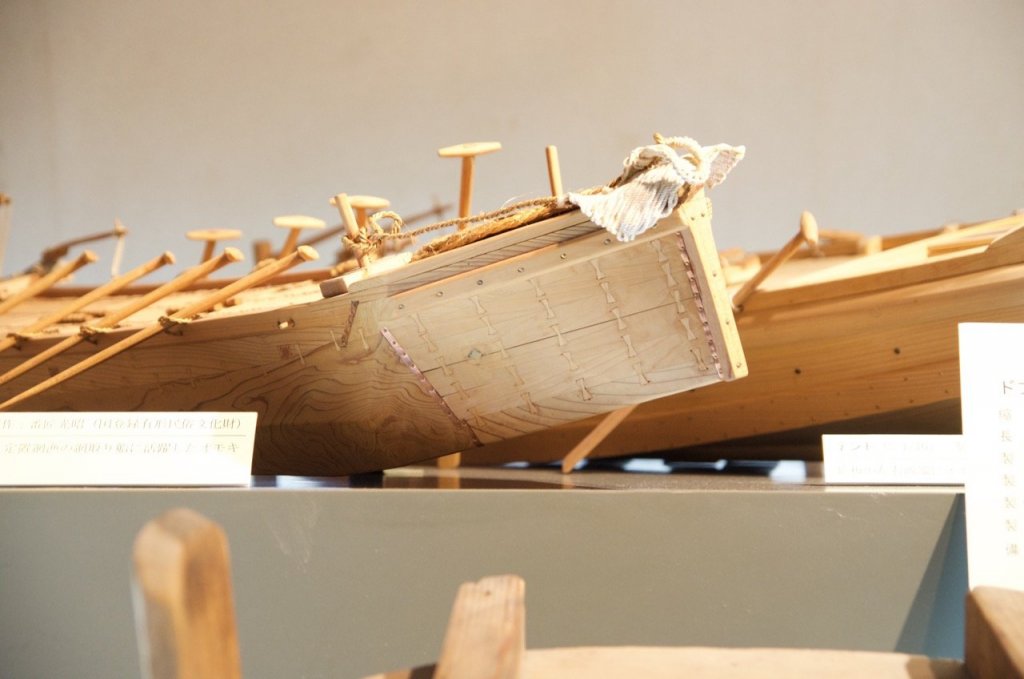
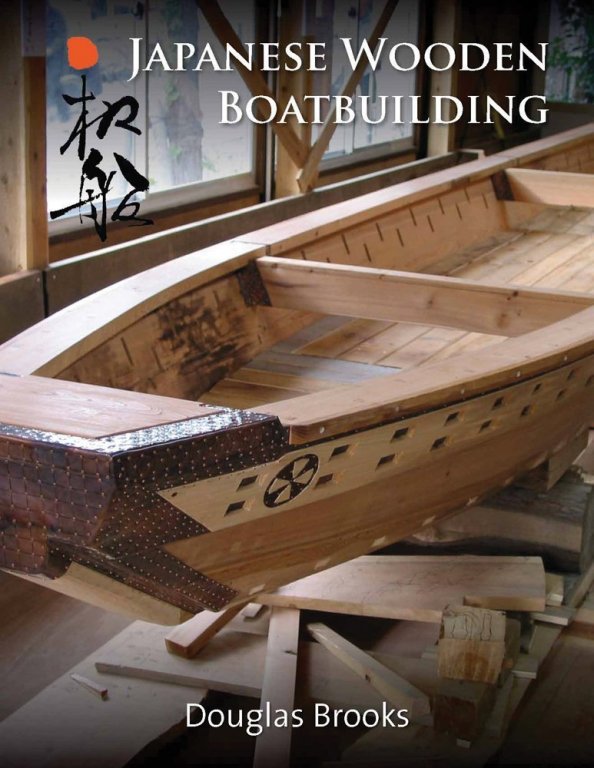
.thumb.jpg.e8d98b168b364befcc907e2c9f152381.jpg)
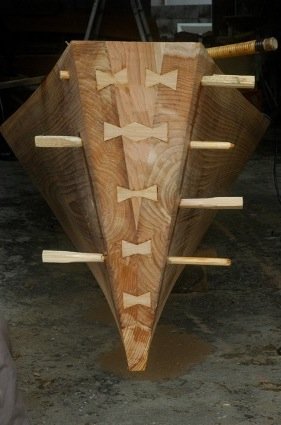
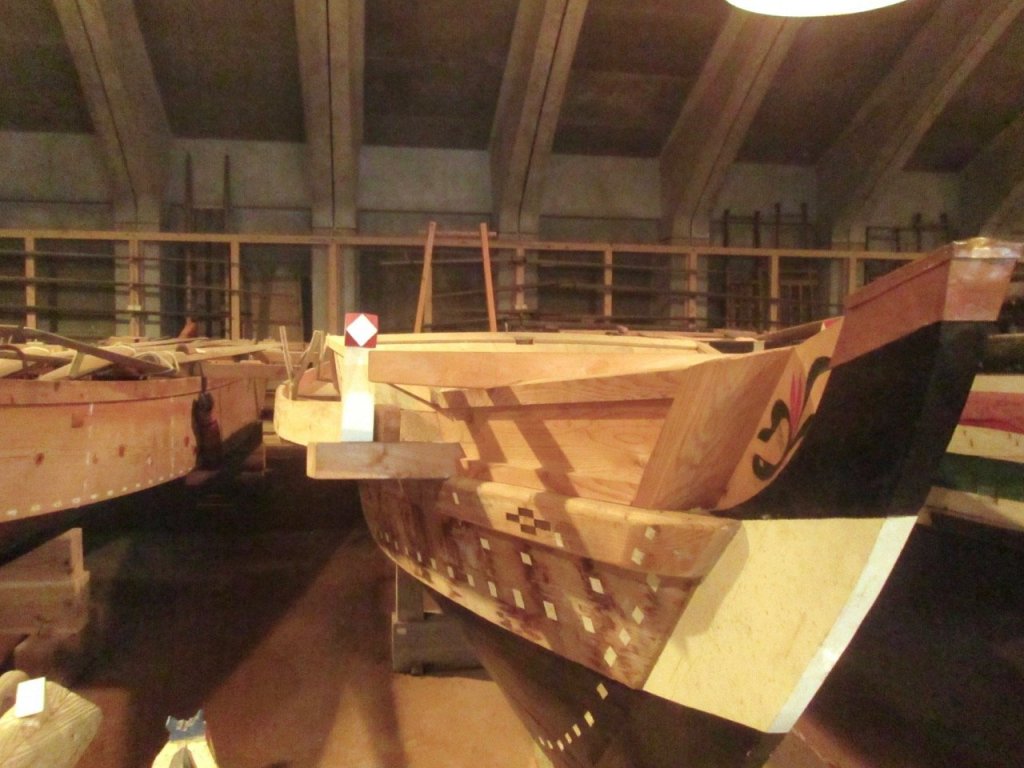
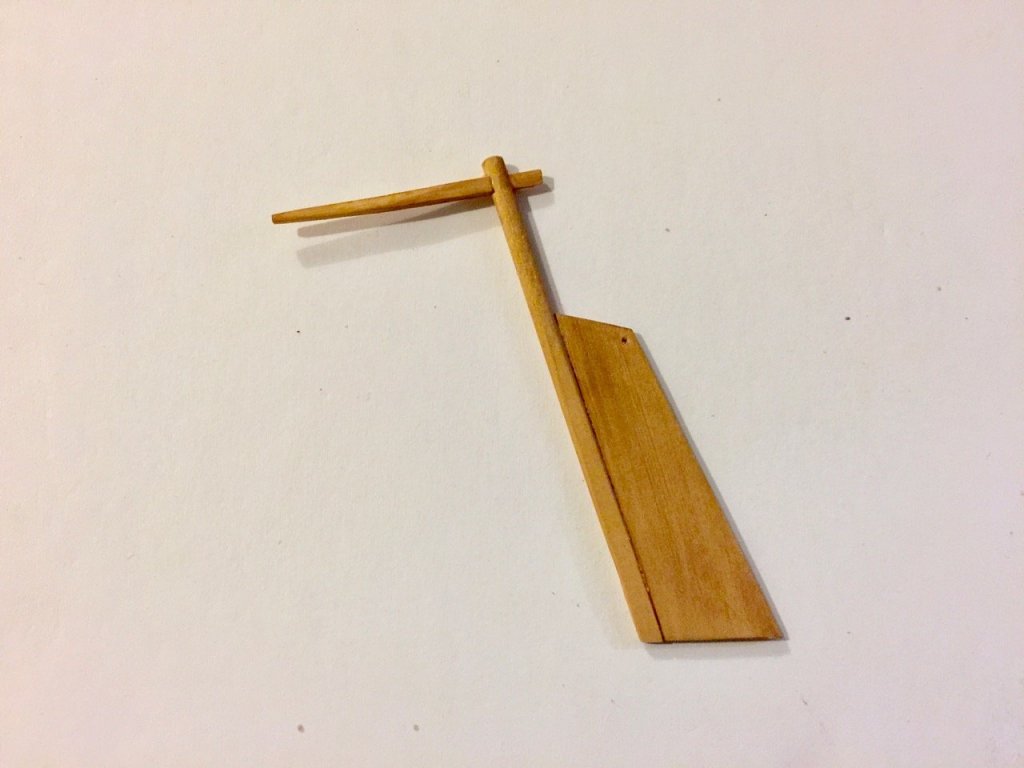
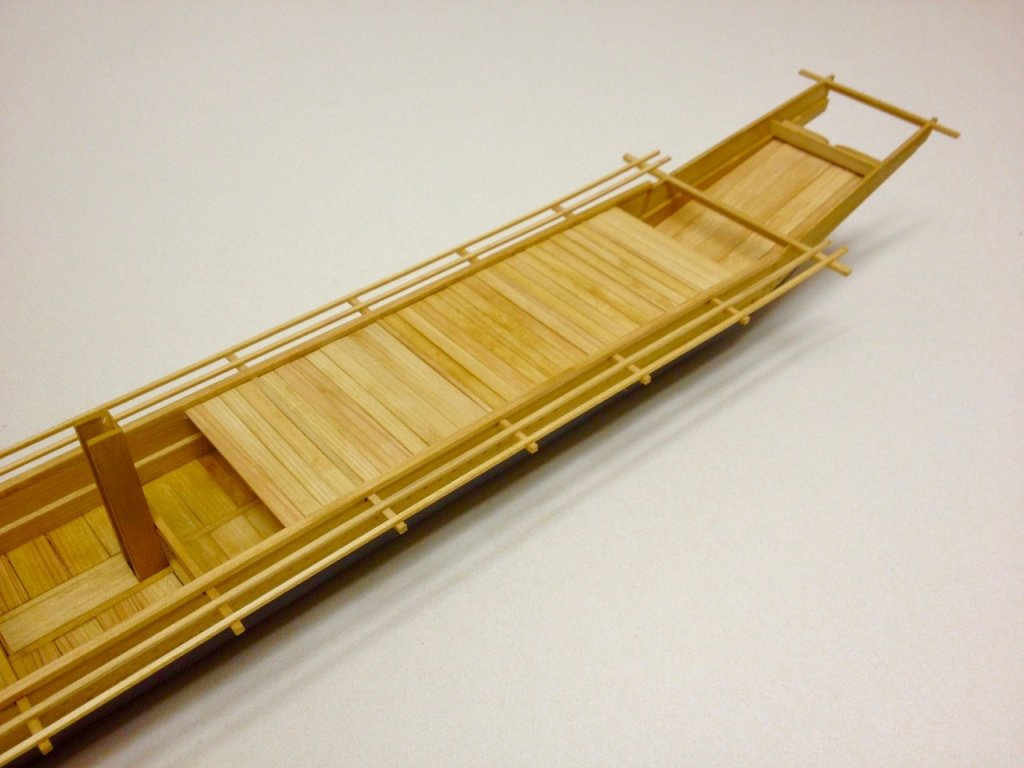
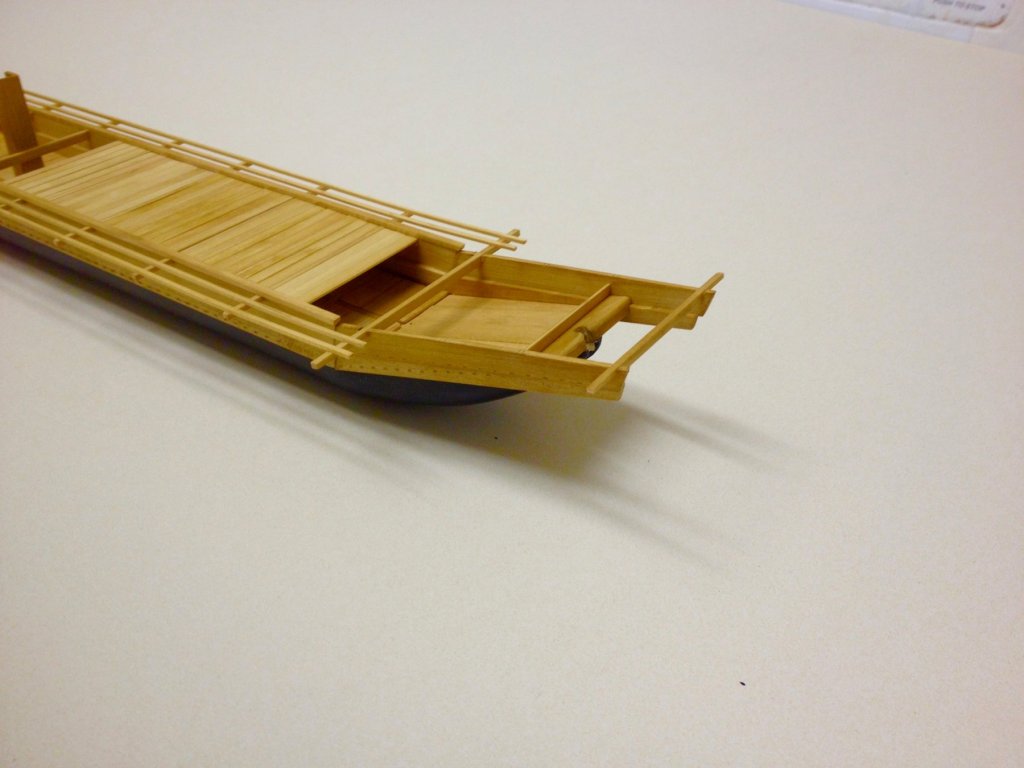
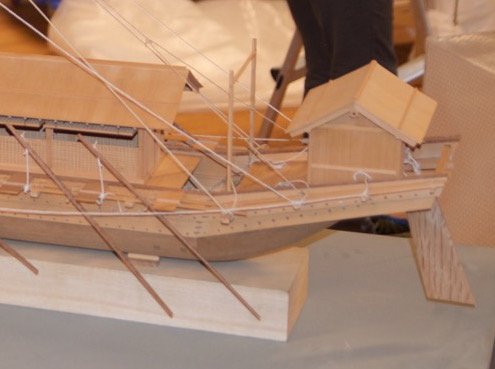
.jpg.9635666575afa97bdcdffdd6ece3f90b.jpg)
